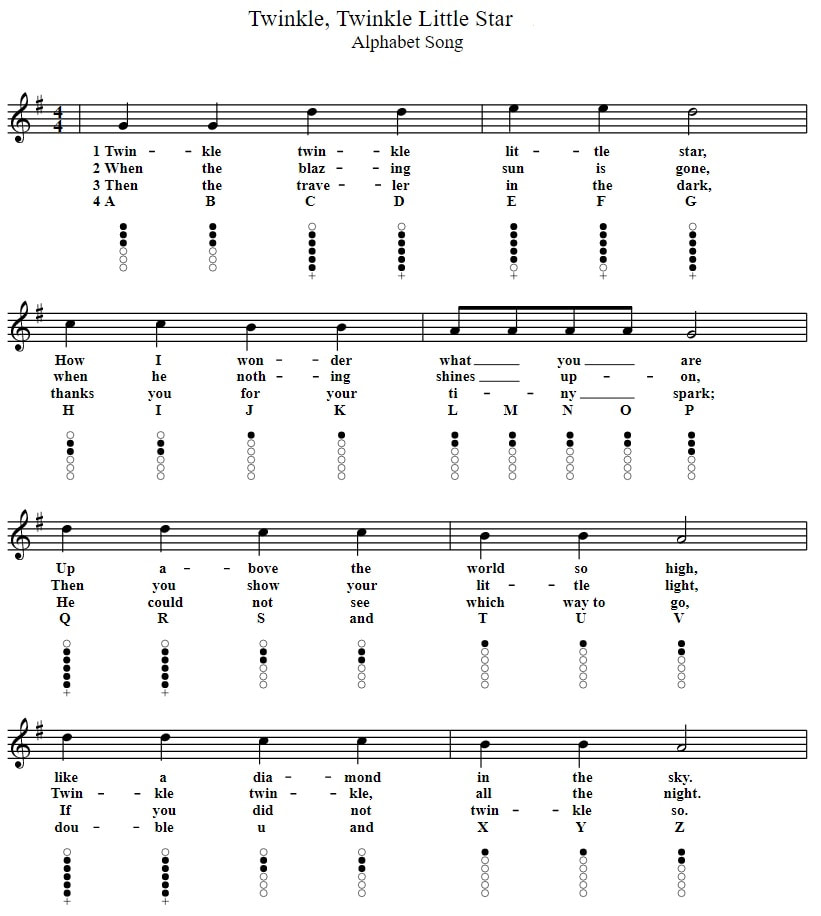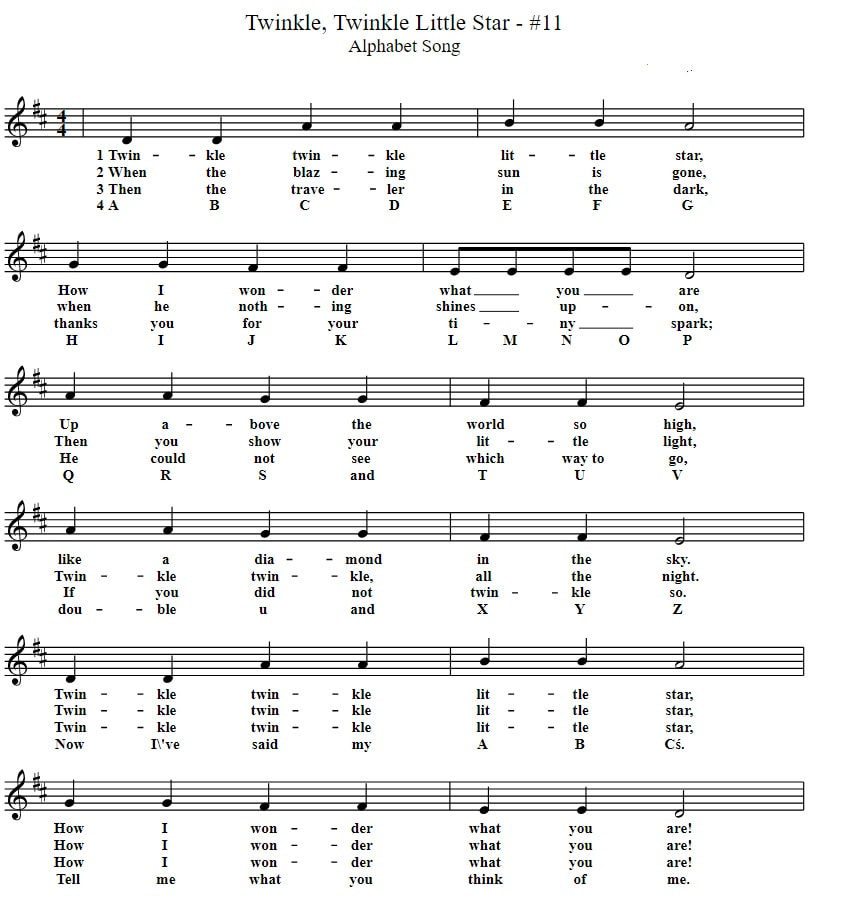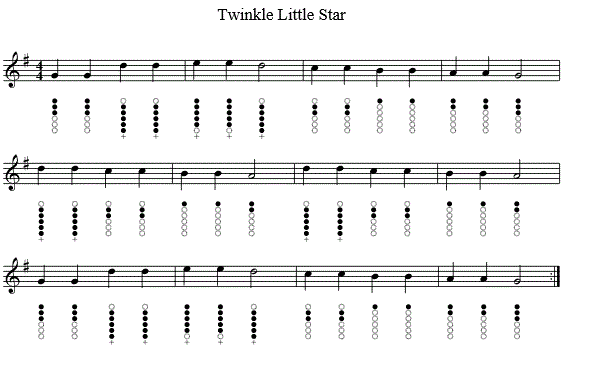Twinkle Twinkle Little Star Sheet Music Guitar Tab And Tin Whistle Notes
The youtube tutorial video will teach you how to play Twinkle Twinkle Little Star On The Tin Whistle.A children's song. The sheet music is in the key of D Major with a version in G also. Twinkle Twinkle Little Star easy recorder notes with finger chart included for beginners. This easy song is part of the Kids Tin Whistle songs . Also included are the letter notes which can be used on the recorder. Guitar chords included.Twinkle Twinkle little star easy beginner piano notes now added for learners plus the tenor guitar / mandola tab in CGDA. Drighligh, drighligh, réalt an-bheag Twinkle Twinkle Little Star In Irish tin whistle tab with chords now included.
Here's the notes in letter form from the
above piece of music starting with the low D.
D D A A B B A
Twinkle, twinkle, little star,
G G F F E E D
How I wonder what you are.
A A G G F F E
Up above the world so high,
A A G G F F E
Like a diamond in the sky.
D D A A B B A
Twinkle, twinkle, little star,
G G F F E E D
How I wonder what you are.
above piece of music starting with the low D.
D D A A B B A
Twinkle, twinkle, little star,
G G F F E E D
How I wonder what you are.
A A G G F F E
Up above the world so high,
A A G G F F E
Like a diamond in the sky.
D D A A B B A
Twinkle, twinkle, little star,
G G F F E E D
How I wonder what you are.
Twinkle Twinkle little star easy beginner piano notes
Below is the list of sheet music and tin whistle songs that are in my ebooks. This is the largest collection of tin whistle songs ever put together.[over 800 songs ] Including folk, pop and trad tunes plus German And French songs along with Christmas Carols.
All of the sheet music tabs have been made as easy to play as was possible.
The price of the ebooks is €7.50
All of the sheet music tabs have been made as easy to play as was possible.
The price of the ebooks is €7.50
The song 'Twinkle Twinkle Little Star' is a beloved childhood classic that has stood the test of time, captivating generations of young children with its simple yet enchanting melody. First published in the late 18th century, the song has since become a cultural phenomenon, being translated into multiple languages and adapted into various forms of media. Despite its seemingly innocent nature, 'Twinkle Twinkle Little Star' holds a deeper significance as a reflection of societal values and the changing perceptions of childhood and education.
The origins of 'Twinkle Twinkle Little Star' can be traced back to a French melody called 'Ah! vous dirai-je, maman' (Ah! Shall I tell you, mother), which was composed by Jean-Philippe Rameau in 1741. The tune was later adapted by Mozart in 1781 for his set of variations for the piano, 'Twelve Variations on Ah! vous dirai-je, maman.' It was not until 1806, however, that the lyrics we know today were added by English poet Jane Taylor, and the song was published in her book 'Rhymes for the Nursery.' This version of the song quickly gained popularity, and it has since been a staple in children's literature and music.
At its core, 'Twinkle Twinkle Little Star' is a lullaby, intended to soothe and comfort young children as they drift off to sleep. The simple and repetitive lyrics, along with the gentle melody, make it easy for children to learn and sing along. This has contributed to the song's enduring popularity, as it is often one of the first songs that children learn and remember. Its use in early childhood education has also been widely recognized, as it helps in developing language and memory skills and encourages creativity and imagination.
Beyond its practical applications, the song has also taken on a deeper cultural significance. In many societies, 'Twinkle Twinkle Little Star' is seen as a symbol of childhood innocence and nostalgia. It is often used in nostalgic media, such as films and TV shows, to evoke a sense of longing for simpler times. The song's lyrics, which speak of a small star shining brightly in the night sky, also hold a deeper meaning, representing the wonder and curiosity of childhood and the human desire to understand the universe.
However, the song has also been subject to various interpretations and adaptations that reflect the changing values and attitudes towards childhood and education. In some versions, the lyrics have been altered to include more educational themes, such as counting or learning the alphabet. This reflects the increasing emphasis on academic achievement and structured learning in modern society. Additionally, the song has been used in advertising and consumer culture, fueling the idea of childhood as a marketable commodity.
The song has also sparked controversy and debate over its original lyrics and their implications. Some have argued that the lyrics perpetuate traditional gender roles, with the line 'like a diamond in the sky' being interpreted as a reference to a little girl being a precious gem. Others have pointed out that the line 'how I wonder what you are' promotes blind acceptance and discourages critical thinking. These criticisms highlight the need for a critical examination of the messages and values that children are exposed to in popular media.
Despite these criticisms, 'Twinkle Twinkle Little Star' remains a cherished part of many childhoods and continues to be passed down from one generation to the next. Its ability to adapt and evolve with changing societal values is a testament to its enduring appeal. Moreover, the song's continued popularity serves as a reminder of the universal experience of childhood and the power of music to connect people across cultures and generations.
In conclusion, 'Twinkle Twinkle Little Star' is much more than just a simple nursery rhyme. It is a reflection of our society's values and perceptions of childhood and education, as well as a source of comfort and nostalgia for many. As we continue to sing this beloved song to our children and grandchildren, it is important to recognize and critically examine its messages and meanings, ensuring that it continues to be a positive and enriching part of childhood for generations to come.
The origins of 'Twinkle Twinkle Little Star' can be traced back to a French melody called 'Ah! vous dirai-je, maman' (Ah! Shall I tell you, mother), which was composed by Jean-Philippe Rameau in 1741. The tune was later adapted by Mozart in 1781 for his set of variations for the piano, 'Twelve Variations on Ah! vous dirai-je, maman.' It was not until 1806, however, that the lyrics we know today were added by English poet Jane Taylor, and the song was published in her book 'Rhymes for the Nursery.' This version of the song quickly gained popularity, and it has since been a staple in children's literature and music.
At its core, 'Twinkle Twinkle Little Star' is a lullaby, intended to soothe and comfort young children as they drift off to sleep. The simple and repetitive lyrics, along with the gentle melody, make it easy for children to learn and sing along. This has contributed to the song's enduring popularity, as it is often one of the first songs that children learn and remember. Its use in early childhood education has also been widely recognized, as it helps in developing language and memory skills and encourages creativity and imagination.
Beyond its practical applications, the song has also taken on a deeper cultural significance. In many societies, 'Twinkle Twinkle Little Star' is seen as a symbol of childhood innocence and nostalgia. It is often used in nostalgic media, such as films and TV shows, to evoke a sense of longing for simpler times. The song's lyrics, which speak of a small star shining brightly in the night sky, also hold a deeper meaning, representing the wonder and curiosity of childhood and the human desire to understand the universe.
However, the song has also been subject to various interpretations and adaptations that reflect the changing values and attitudes towards childhood and education. In some versions, the lyrics have been altered to include more educational themes, such as counting or learning the alphabet. This reflects the increasing emphasis on academic achievement and structured learning in modern society. Additionally, the song has been used in advertising and consumer culture, fueling the idea of childhood as a marketable commodity.
The song has also sparked controversy and debate over its original lyrics and their implications. Some have argued that the lyrics perpetuate traditional gender roles, with the line 'like a diamond in the sky' being interpreted as a reference to a little girl being a precious gem. Others have pointed out that the line 'how I wonder what you are' promotes blind acceptance and discourages critical thinking. These criticisms highlight the need for a critical examination of the messages and values that children are exposed to in popular media.
Despite these criticisms, 'Twinkle Twinkle Little Star' remains a cherished part of many childhoods and continues to be passed down from one generation to the next. Its ability to adapt and evolve with changing societal values is a testament to its enduring appeal. Moreover, the song's continued popularity serves as a reminder of the universal experience of childhood and the power of music to connect people across cultures and generations.
In conclusion, 'Twinkle Twinkle Little Star' is much more than just a simple nursery rhyme. It is a reflection of our society's values and perceptions of childhood and education, as well as a source of comfort and nostalgia for many. As we continue to sing this beloved song to our children and grandchildren, it is important to recognize and critically examine its messages and meanings, ensuring that it continues to be a positive and enriching part of childhood for generations to come.
Drighligh, drighligh, réalt an-bheag Twinkle Twinkle Little Star In Irish
twinkle twinkle little star guitar tab and chords in D Major
Twinkle twinkle little star tenor guitar / mandola tab in CGDA













